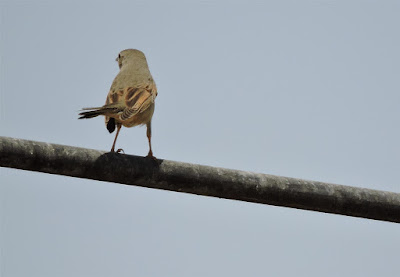The first one was Ghaftain which I arrived at while it was still very cool.
Like all of the smaller desert stops, the passage can be very variable from day to day. This time it was at best average.
There were the first lesser whitethroat I had seen there. There were also several Daurian shrike and Turkestan shrike. There was also at least one citrine wagtail and one yellow wagtail but there was nothing extraordinary. It can't happen every time.
hoopoe at Ghaftain
rosy starling at Ghaftain
I saw only one golden oriole this time at Ghaftain.
golden oriole at Muntasar
In contrast there were at least eight at my next stop which was Muntasar oasis.
There are always moorhen there now and they must be breeding in this remote watering hole. The other two local breeders are Eurasian collared dove and house sparrow.
kestrel
A very tired looking kestrel was on site.
spotted flycatcher
Qatbeet was the next stop but there was nothing special.
Dowkah was my last stop and is the largest desert location. It has never failed me for interest.
Once again there were signs of heavy passage including a variety of waders and passerines. For example 25 collared pratincole were observed in one field. I would have missed them altogether if a Montagu's harrier hadn't moved in and created panic. In the same field I counted 10 European roller and 9 golden oriole on the pivot bar.
Ocassionally a warbler perches on a pivot bar but not often. This time a common whitethroat was out in the open doing so.
common whitethroat
One went into a neighbouring palm and afforded excellent views though it knew I was there and spent most of its time looking directly at me.
European scops owl looking at me
At one moment, a group of Eurasian collared dove decided to panic and flew off with great noise. The European scops owl stayed rooted but swivelled it head for a moment in their direction before returning its gaze at me.
European scops owl looking aside
The waves of common rock thrush seen in this patch in recent visits is seeming over. However a blue rock thrush was there.
blue rock thrush
Likewise the large wave of European nightjar is apparently mostly over but I still managed to observe two late ones.
European nightjar
While I was on site, a small flock of 9 white stork dropped into the farm. Sometimes white stork stay all winter at these farms. It remains to be seen if these will do so.
white stork
Soon after this sighting I headed on towards to Salalah but this was my last stop on an exhausting and rewarding Eid break.












Impressive selection.
ReplyDeleteThank you Andrew
Delete